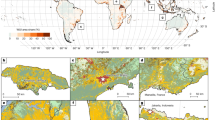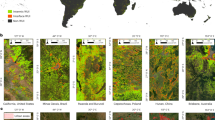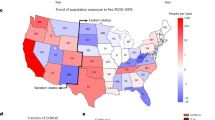Abstract
The wildland–urban interface (WUI) is defined in terms of housing density and proximity to wildlands, yet its relevance seems to be only in conjunction with wildland fire threats. The objective of this paper is to (1) identify the WUI areas threatened from wildfire during the 2000’s and (2) quantify the values that were threatened. We use 1 km fire detection data generated using MODIS satellite imagery over a 10-year period combined with population densities to identify threatened areas of the WUI. We then use data on structures, structure content, and population to identify the people and property threatened from identified fires within the WUI. We find that 6.3 % of the U.S. population (17.5 million) resided within these areas and that 2.1 % of the population lived in WUI areas where more than one fire has occurred. However, we find that only a third of the affected population was threatened during daytime hours, as most leave the threatened portion of the WUI during peak ignition hours. The threatened area comprised 4.1 % of the coterminous USA and 44.9 % of the WUI. Within these areas were 7.8 million residential, commercial, industrial, governmental, religious, and educational structures, with a building and building content value estimated at $1.9 trillion. Overall, 7.3 % of residential structures in the USA were found within the WUI with wildfire activity; however, for some states, this number was as high as 25.4 %.

Similar content being viewed by others
Notes
Suburban area is defined as the metropolitan area outside the central city (Hobbs and Stoops 2002).
For instance, the Old, Grand Prix, and Padua Complex in 2003 resulted in 787 total and 3,860 partial loss claims (Western Forestry Leadership Coalition 2010).
For instance, the Painted Cave fire, for example, burned 479 homes within a few hours, and the Laguna Hills fire burned 366 homes in 5 h (Cohen 2000).
WUI GIS downloaded from SILVIS Lab, Department of Forest Ecology and Management, University of Wisconsin-Madison, on May 9, 2007.
Other WUI definitions exist. For a discussion of their merits and implications, see Stewart et al. (2009).
The Federal Register (2001) defines the interface as: “The Interface Community exists where structures directly abut wildland fuels.”
The Federal Register (2001) defines the intermix as: “The Intermix Community exists where structures are scattered throughout a wildland area.”
Population of the contiguous USA.
References
Butry DT, Donovan GH (2008) Protect thy neighbor: investigating the spatial externalities of community wildfire hazard mitigation. For Sci 54(4):417–428
California Fire Alliance (2001) Characterizing the Fire Threat to Wildland–Urban Interface Areas in California. http://frap.cdf.ca.gov/projects/wui/525_CA_wui_analysis.pdf
Champ PA, Donovan GH, Barth CM (2013) Living in a tinderbox: wildfire risk perceptions and mitigating behaviours. Int J Wildland Fire 22(6):832–840. doi:10.1071/WF12093
Cohen JD (2000) Preventing disaster: home ignitability in the wildland–urban interface. J For 98(3):15–21
Colorado State Forest Service (2004) Interface areas of high wildfire risk in Colorado. http://csfs.colostate.edu/pages/documents/Redzone_11x17_flat.pdf
Federal Register (2001) vol 66, no 3. January 2001. 752–753
Federal Emergency Management Administration (2009) HAZUS-MH MR4. Version 1.4. http://www.fema.gov/plan/prevent/hazus/
Finney MA (2005) The challenge of quantitative risk analysis for wildland fire. For Ecol Manag 211:97–108
Fire and Resource Assessment Program, California Department of Forestry and Fire Protection (2003) Wildfire risks to assets. http://frap.cdf.ca.gov/assessment2003/Chapter3_Quality/wildfirerisk1.pdf
Giglio L, Descloitres J, Justice CO (1999) Evaluation of global fire detection algorithms using simulated AVHRR infrared data. Int J Remote Sens 20(10):1947–1985
Giglio L, Descloitres J, Justice CO, Kaufman YJ (2003) An enhanced contextual fire detection algorithm for MODIS. Remote Sens Environ 87:273–282
Giglio L, Csiszar I, Justice CO (2006) Global distribution and seasonality of active fires as observed with the terra and aqua moderate resolution imaging spectroradiometer (MODIS) sensors. J Geophys Res 111:G02016. doi:10.1029/2005JG000142
Haight RG, Cleland DT, Hammer RB, Radeloff VC, Scott Rupp T (2004) Assessing fire risk in the wildland–urban interface. J For 102(7):41–48
Hammer RB, Stewart SI, Winkler RL, Radeloff VC, Voss PR (2004) Characterizing dynamic spatial and temporal residential density patterns from 1940 to 1990 across the North Central United States. Landsc Urban Plan 69:183–199
Hawbaker TJ, Radeloff VC, Syphard AD, Zhu Z, Stewart SI (2008) Detection rates of the MODIS active fire product in the United States. Remote Sens Environ 112:2656–2664
Hobbs F, Stoops N (2002) Demographic trends in the 20th century: census 200 special reports. CENSR-4. November 2002. http://www.census.gov/prod/2002pubs/censr-4.pdf
Iceland J, Steinmetz E (2003) The effects of using census block groups instead of census tracts when examining residential housing patterns. July 2003. https://www.census.gov/hhes/www/housing/housing_patterns/pdf/unit_of_analysis.pdf
Justice CO, Giglio L, Korontzi S, Owens J, Morisette JT, Roy D, Descloitres J, Alleaume S, Petitcolin F, Kaufman Y (2002) The MODIS fire products. Remote Sens Environ 83:244–262
Menakis JP, Cohen J, Bradshaw L (2000) Mapping wildland fire risk to flammable structures for the conterminous United States. In: Proceedings of fire conference 2000: The first national congress on fire ecology, prevention, and management. Miscellaneous Publication No. 13, Tall Timbers Research Station, Tallahassee, FL
Morisett JT, Giglio L, Csiszar I, Setzer A, Schroeder W, Morton D, Justice CO (2005) Validation of MODIS active fire detection products derived from two algorithms. Earth Interact 9(9):EI141
Morisette JT, Giglio L, Csiszar I, Justice CO (2005) Validation of the MODIS active fire product over Southern Africa with ASTER data. Int J Remote Sens 26(19):4239–4264
National Aeronautics and Space Administration (2011) MODIS. http://modis.gsfc.nasa.gov/
National Interagency Fire Center (2010) Wildland fire statistics. http://www.nifc.gov/fire_info/fires_acres.htm
Radeloff VC, Hammer RB, Stewart SI , Fried JS, Holcomb SS, McKeefry JF (2005) The Wildland Urban Interface in the United States. Ecol Appl 15:799–805
Schmidt KM, Menakis JP, Hardy CC, Hann WJ, Bunnell DL (2002) Development of Coarse-Scale Spatial Data for Wildland Fire and Fuel Management. General Technical Report RMRS-GTR-87, U.S. Department of Agriculture, Forest Service
Schroeder W, Prins E, Giglio L, Csiszar I, Schmidt C, Morisette J, Morton D (2008) Validation of GOES and MODIS active fire detection products using ASTER and ETM + Data
Silvis Laboratories (2000) Wildland–urban interface maps, statistics, and data. http://silvis.forest.wisc.edu/old/Library/WUILibrary.php
Stewart S, Radeloff V, Hammer R, Fried J (2005) Mapping the wildland urban interface and projecting its growth to 2030: summary statistics. Silvis Laboratories. January 2005. http://silvis.forest.wisc.edu/old/Library/Stats/uswuistats.pdf
Stewart SI, Wilmer B, Hammer RB, Aplet GH, Hawbaker TJ, Miller C, Radeloff VC (2009) Wildland–urban interface maps vary with purpose and context. J For 107(2):78–83
Strauss D, Bednar L, Mees R (1989) Do one percent of the forest fires cause ninety-nine percent of the damage? For Sci 35(2):319–328
Sullivan WC III (1994) Perceptions of the rural–urban fringe: citizen preferences for natural and developed settings. Landsc Urban Plan 29:85–101
Theobald DM, Romme WH (2007) Expansion of the US wildland–urban interface. Landsc Urban Plan 83:340–354
University of Maryland (2011) MODIS active fire and burned area products. http://modis-fire.umd.edu/index.html
U.S. Census Bureau. Table 1. Urban and rural population: 1900 to 1990. http://www.census.gov/population/censusdata/urpop0090.txt. Accessed Aug 8, 2010
U.S. Census Bureau. GCT-P1. Urban/rural and inside/outside metropolitan area: 2000. http://factfinder.census.gov/servlet/GCTTable?_bm=y&-geo_id=01000US&-_box_head_nbr=GCT-P1&-ds_name=DEC_2000_SF1_U&-redoLog=false&-format=US-1&-mt_name=DEC_2000_SF1_U_GCTP1_US1. Accessed Aug 8, 2010
U.S. Forest Service (2011) Fire detection GIS data. http://activefiremaps.fs.fed.us/gisdata.php
Western Forestry Leadership Coalition (2010) The true cost of wildfire in the Western U.S. http://www.wflccenter.org/news_pdf/324_pdf.pdf
Author information
Authors and Affiliations
Corresponding author
Rights and permissions
About this article
Cite this article
Thomas, D.S., Butry, D.T. Areas of the U.S. wildland–urban interface threatened by wildfire during the 2001–2010 decade. Nat Hazards 71, 1561–1585 (2014). https://doi.org/10.1007/s11069-013-0965-7
Received:
Accepted:
Published:
Issue Date:
DOI: https://doi.org/10.1007/s11069-013-0965-7




